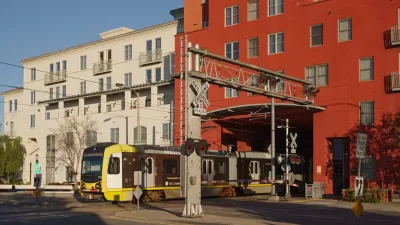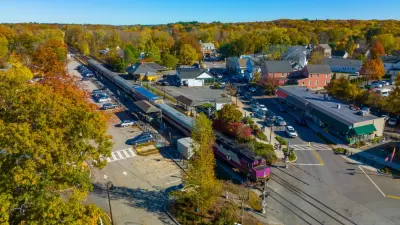A Massachusetts law aimed at reducing the state's housing shortage mandates zoning for multi-family housing in most eastern Massachusetts jurisdictions.

A Massachusetts state bill designed to boost housing production and increase density near transit will limit access to state grants for municipalities that don't comply with upzoning regulations, reports Henry Grabar.
The law mandates that communities zone for "as-of-right" multi-family apartment construction in formerly single-family neighborhoods in order to alleviate the state's housing shortage. As Grabar notes, "The mandate applies to places served by or adjacent to stations of the Massachusetts Bay Transportation Authority, the state agency that operates the buses and trains that fan out of Boston," with the biggest burden placed on "bedroom suburbs" that, despite having excellent transit, continue to limit housing production with exclusionary zoning that keeps housing costs high and supply low.
The new regulations require designated communities to zone or rezone at least one district to 15 homes per acre, compared to the current average of 6.2 homes per acre. Grabar points out that "That corresponds to a relatively dense but recognizably suburban fabric, such as town houses or duplexes around shared yards."
While state leaders hope a blanket policy will eliminate lengthy local hearing processes and reduce development costs, there are concerns about ways that resistant communities could circumvent or ignore the new law by adjusting zoning maps or imposing unreasonable restrictions.
FULL STORY: Can You Force the Suburbs to Build Apartments? Massachusetts Is Trying.

Alabama: Trump Terminates Settlements for Black Communities Harmed By Raw Sewage
Trump deemed the landmark civil rights agreement “illegal DEI and environmental justice policy.”

Planetizen Federal Action Tracker
A weekly monitor of how Trump’s orders and actions are impacting planners and planning in America.

The 120 Year Old Tiny Home Villages That Sheltered San Francisco’s Earthquake Refugees
More than a century ago, San Francisco mobilized to house thousands of residents displaced by the 1906 earthquake. Could their strategy offer a model for the present?

In Both Crashes and Crime, Public Transportation is Far Safer than Driving
Contrary to popular assumptions, public transportation has far lower crash and crime rates than automobile travel. For safer communities, improve and encourage transit travel.

Report: Zoning Reforms Should Complement Nashville’s Ambitious Transit Plan
Without reform, restrictive zoning codes will limit the impact of the city’s planned transit expansion and could exclude some of the residents who depend on transit the most.

Judge Orders Release of Frozen IRA, IIJA Funding
The decision is a victory for environmental groups who charged that freezing funds for critical infrastructure and disaster response programs caused “real and irreparable harm” to communities.
Urban Design for Planners 1: Software Tools
This six-course series explores essential urban design concepts using open source software and equips planners with the tools they need to participate fully in the urban design process.
Planning for Universal Design
Learn the tools for implementing Universal Design in planning regulations.
Clanton & Associates, Inc.
Jessamine County Fiscal Court
Institute for Housing and Urban Development Studies (IHS)
City of Grandview
Harvard GSD Executive Education
Toledo-Lucas County Plan Commissions
Salt Lake City
NYU Wagner Graduate School of Public Service





























